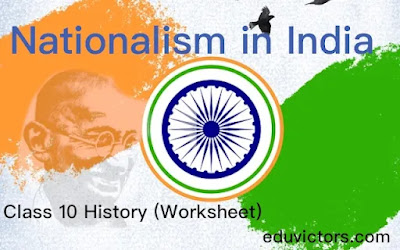CBSE Class 10 - History - Nationalism in India (Worksheet)
Fill in the blanks with suitable words.
1. The First World War was started in year ______ and ended in year ______.
2. In 1919, an act was passed by Imperial Legislative Council without the support of Indian members. The Act gave enormous powers to the government to repress political activities and allowed the detention of political prisoners without trial for two years. We are talking about ________ act.
3. After the end of the first World War, there were rumours that a harsh peace treaty was going to be imposed on the Ottoman emperor (Khalifa - the spiritual head of the Islamic world). To oppose the treaty, a ________ Committee was formed in Bombay in March 1919 by Muhammad Ali and Shaukat Ali.
4. At the Calcutta session of Congress in September 1920, a resolution was passed to launch a __________ Movement in support of Khilafat as well as for Swaraj.
5. The British government constituted a Statuary Commission led by Sir _____ ______. The Commission would look into the functioning of the constitutional system in India and suggest changes. All political leaders in India opposed it since there were no Indian members in the Commission. When the members of the Commission arrived in India in 1928, they were greeted with the slogan "Go Back".
6. The Salt March or Dandi March was started by Gandhiji on ____ March, _____. The Salt March marked the beginning of ________ movement.
7. In Awadh, a movement was led by Baba _______ against the landlords and talukdars because they demanded high rents and many other cesses.
8. In the Gudem hills a militant guerrilla movement spread in the early 1920s because they were prevented from entering the forest to graze cattle, to collect fruits and firewood. Labour that villagers were forced to contribute without any payment called ___________ . The guerrilla warfare movement was led by __________.
9. Plantation workers revolted against the _________ Act of 1859, which did not permit the workers to leave the tea gardens without permission and they were rarely given such permissions.
10. Due to the Chauri Chaura incident (1922) and other violent activities in many places, Mahatma Gandhi decided to withdraw the _________ Movement.
11. Dr B R Ambedkar demanded separate electorates for Dalits. When the British colonial government accepted the demand, it was opposed by Gandhiji. He believed that it would slow down the process of integration of society. A Pact was signed between B.R. Ambedkar and Mahatma Gandhi at ______ in 1932.
12. Mahatma Gandhi opposed untouchability and gave another name to Dalits i.e. _______ which means children of God. He organised Satyagraha for them to secure their entry into temples, public wells, tanks, roads and schools.
13(HOTS). The ________ Movement was started by Mahatma Gandhi on 9 August 1942, asking for an end to British rule in India. The movement was started in a speech in Bombay, where Mahatma Gandhi asked Indians to Do or Die.
Answers:
1: 1914, 1919
2: Rowlatt
3: Khilafat
4: Non-Cooperation
5: John Simon.
6: 12th, 1930, Civil Disobedience
7: Ramchandra
8: begar, Alluri Sitaram Raju
9: Inland Emigration
10: Non-Cooperation
11: Poona
12: Harijans
13: Quit India
History - CH3 - Nationalism In India (VSQA)
History - CH3 - Nationalism in India (MCQs)
History - CH3 - Nationalism in India (Question Bank)
History - CH3 - Nationalism in India (MCQs-2)

No comments:
Post a Comment
We love to hear your thoughts about this post!
Note: only a member of this blog may post a comment.